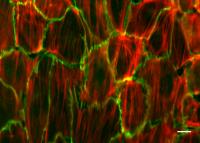
UCSD bioengineers have found a link between parallel alignment of 'stress fibers' in blood vessel cells and healthy levels in those cells of a protein called JNK.Atherosclerotic narrowing and hardening of coronary arteries typically appear first at vessel branches, and a study in the October issue of Cellular Signalling reports that the type of mechanical stretching found at those branches activates a cellular protein known to damage cells. The report is the first to link mechanical forces with structural and biochemical changes in blood vessel cells that could explain why atherosclerotic lesions form preferentially at branches of coronary arteries.
The findings, which are currently available online at the journal's Website, were reported by a team of scientists at the University of California, San Diego as part of an ongoing effort to understand how mechanical forces affect the health of cells that line arteries.
The cellular protein in question is called JNK, which is short for c-jun N-terminal kinase. The protein is a key barometer of outside stresses on a variety of cell types. Researchers are examining the role of JNK in many diseases because it regulates the expression of genes involved in programmed cell death, tumor genesis, and other stress responses.
Atherosclerosis, the collection of deposits such as cholesterol along artery walls, accounts for nearly 75 percent of deaths from cardiovascular disease. Most drugs to treat atherosclerosis influence the levels of cholesterol and other lipids in the blood, but the UCSD researchers suspect that understanding the role of mechanical forces acting on blood vessel cells may help to design better approaches to treatment.
"We've known for decades that atherosclerotic lesions develop preferentially at vessel branches rather than along unbranched vessels, but we've not been able to identify the biochemical events that trigger formation of the lesions," said Chien, director of the Whitaker Institute of Biomedical Engineering at UCSD. "We now have identified a possible smoking gun: activation of JNK, which is dependent on the directionality of blood vessel stretching."
Chien, research scientist Shunichi Usami, and post-doctoral fellow Roland Kaunas, now an assistant professor of biomedical engineering at Texas A&M University, isolated endothelial cells from the bovine aorta and grew them in culture flasks. They seeded the cells onto silicone rubber membranes that had been coated with a protein that allowed the cells to attach the way they do to underlying blood vessel tissue in the body. They then stretched endothelial cells 10 percent of their length 60 times per minute to simulate the rhythmic flexing of an artery in response to heart beats.
Cells that were stretched back and forth along one axis exhibited a healthy response: the level of JNK rose and quickly returned to basal levels as the cells also produced well-aligned intracellular actin fibers that were aligned perpendicular to the axis of stretch. When the researchers stretched cells in two directions simultaneously, they noted an unhealthy response: actin fibers oriented randomly and JNK concentrations rose to higher levels and remain elevated.
"We're continually amazed at how quickly these cells can reorient these stress fibers when we change the direction of stretch," said Chien. "At the same time, the actin cytoskeleton of endothelial cells is somehow playing a key role in activating and deactivating JNK."
The tubular geometry of the straight part of arteries ensures that the cyclical rise and fall of blood pressure results in uniaxial stretch of arteries. However, the more complex geometry of artery branches promotes an unhealthy stretching of the blood vessel along more than one axis.
A second mechanical force, the so-called shear force of blood flowing through vessels, also influences the orientation of stress fibers in endothelial cells. A laminar flow of blood prompts stress fibers to orient in the healthy direction, while disturbed and low blood flows caused stress fibers to form in an unhealthy, random orientation. Chien's group is now working to understand how both stretching and shear forces influence JNK activation.
"We still need to limit the amount of cholesterol in our diet, especially the low-density lipoprotein, or bad cholesterol," said Chien. "But our new understanding of how mechanical forces affect JNK will eventually help us gain better understanding of the mechanism underlying the focal localization of atherosclerotic lesions and design better approaches to treat this important disease state."
Source : University of California - San Diego
 Print Article
Print Article Mail to a Friend
Mail to a Friend
